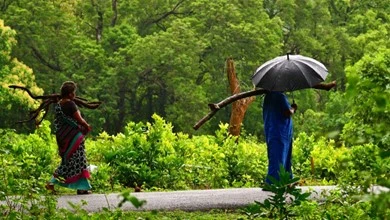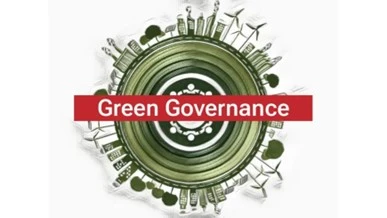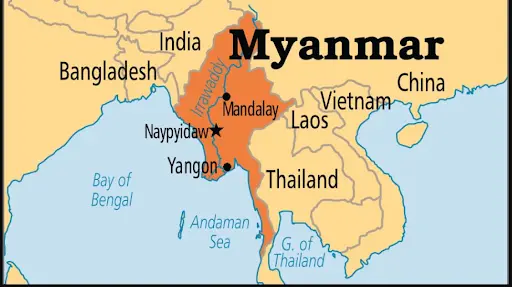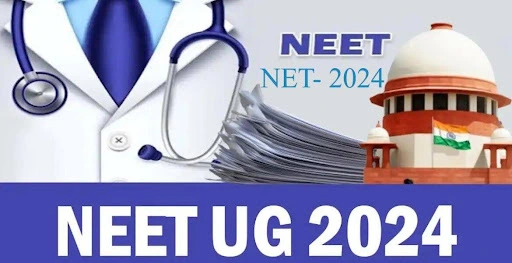Thursday, 27th June 2024
Maharashtra’s Water Crisis
Why in the News?
- Recently, following last year's deficient monsoon, the Maharashtra government declared several parts of the state as drought-hit.
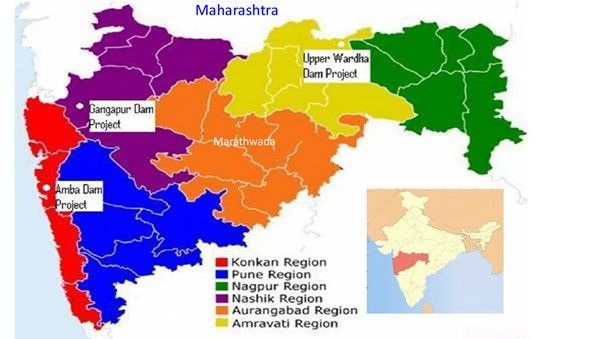
What are the reasons for drought in many parts of maharashtra?
- Rain-shadow Region: Marathwada lies in the rain-shadow of the Western Ghats, receiving lower rainfall due to the blocking effect of these mountains. It averages 600-800 mm of rainfall annually.
- Climate Change Impact: Climate change has increased drought severity and frequency in Maharashtra. Marathwada and North Karnataka are now among India's driest regions, with rainfall patterns increasingly erratic.
- Soil Type: Marathwada's predominant soil type is clayey black soil (regur), which retains moisture well but has a low infiltration rate. This limits water percolation and groundwater recharge.
- Topographic Variation: The region's topography includes parallel tributaries of the Godavari and Krishna rivers, creating valleys with perennial groundwater and uplands with seasonal availability. Wells in upland areas often dry up post-monsoon.
- Promotion of Water-Intensive Crops: Government subsidies and policies supporting sugarcane cultivation prioritise water-intensive irrigation practices, significantly reducing water availability for other nutritious crops. For every acre of sugarcane, four acres of traditional crops suffer water scarcity.
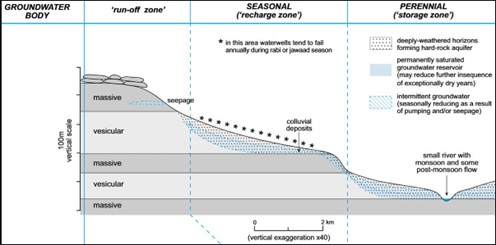
Why is Sugarcane Production Not Suited for Regions with Less Rainfall?
- High Water Requirement: Sugarcane requires 1,500-2,500 mm of water during its growing season, exceeding annual rainfall in low-rainfall areas like Marathwada.
- Irrigation Demands: Sugarcane's daily irrigation needs consume 61% of the region's irrigation water while occupying only 4% of the cropped area, limiting water availability for more suitable crops.
- Government Policies: Historical support for sugarcane pricing and promotion of sugarcane-juice-based ethanol production divert water resources from sustainable agricultural practices.

What is Meant by the Rain-Shadow Effect?
- Moist winds from the Arabian Sea rise over the Western Ghats, causing heavy rainfall on the western side.
- On the eastern side (Western Maharashtra and Marathwada), these winds descend with reduced moisture, resulting in lower rainfall.
- Marathwada receives 600-800 mm of annual rainfall due to its location in the rain-shadow region, contributing to its dry climate and water scarcity.
How Can Supply-Side Solutions Help the Situation?
- Watershed Management: Constructing water-conserving structures like contour trenches, earthen bunds, and gully plugs to capture and store runoff. Implementing silt-trapping mechanisms to prevent soil erosion and maintain water retention.
- Interlinking of Rivers: The national interlinking of rivers (ILR) is the idea that rivers should be inter-connected, so that water from the surplus rivers and regions could be transferred to deficient regions and rivers to address the issue of water scarcity.
- Promote Water Conservation: Encourage rainwater harvesting, efficient irrigation, and reduce water wastage across sectors through public awareness and policy support.
- Invest in Water Infrastructure: Utilise innovative financing like public-private partnerships and water tariffs to ensure sustainable development of water infrastructure.
- Promoting Water-Efficient Practices: Encouraging water-efficient irrigation methods such as drip irrigation and shifting to drought-resistant and high-value crops to reduce water demand and improve sustainability.
- Adopt One Water Approach:
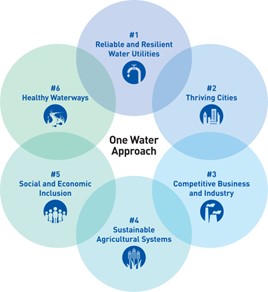
What are the Key Government Schemes to the Water Crisis?
- MGNREGA for water conservation: Provides rural jobs for water projects like check dams. Over 5 million water-related structures were built, enhancing water availability in drought-prone regions and benefiting millions of households.
- Jal Kranti Abhiyan: Promotes rainwater harvesting and watershed development. Campaigns reach 500 districts, focusing on sustainable water management and raising awareness about water conservation practices across India.
- National Water Mission: Aims for integrated water resource management. Targets 20% water use efficiency improvement. Focuses on sustainable development, ensuring water security through optimal utilisation and conservation of water resources.
- Atal Bhujal Yojana (ABHY): Targets community-led groundwater management in 8,350 water-stressed areas. Aims to cover 835,000 hectares with water conservation practices, ensuring sustainable groundwater use and recharge.
- Jal Jeevan Mission (JJM): Plans to provide tap water to all rural households by 2024. Aims to cover 112 million rural households, emphasising local water resource management and quality improvement.
- National Mission for Clean Ganga (NMCG): Focuses on Ganga rejuvenation. 300 projects initiated for sewage treatment, afforestation, and river basin management. Aims for sustainable development, benefiting 500 million people in Ganga basin.
Conclusion:
- The Maharashtra government announced a Rs 59,000 crore package to transform Marathwada, focusing on resolving the water crisis. This includes reviving irrigation projects to achieve drought-free status through water linking and floodwater diversion to the Godavari basin.
|
UPSC Civil Services Examination, Previous Year Questions (PYQs) Prelims: Q:1 What are the benefits of implementing the ‘Integrated Watershed Development Programme’? (2014)
Select the correct answer using the code given below: (a) 1 and 2 only (b) 2, 3 and 4 only (c) 1, 3 and 4 only (d) 1, 2, 3 and 4 Ans: C
Mains: Q:1 What is water stress? How and why does it differ regionally in India? (2019) Q:2 Elaborate the impact of the National Watershed Project in increasing agricultural production from water stressed areas. (2019) |
Source: TH
India needs the anchor of a national security strategy
Why in the news?
- Recently, the elected National Democratic Alliance government faces numerous longstanding and intricate national security challenges and their management in border areas, linkages of Organised crime with terrorism.
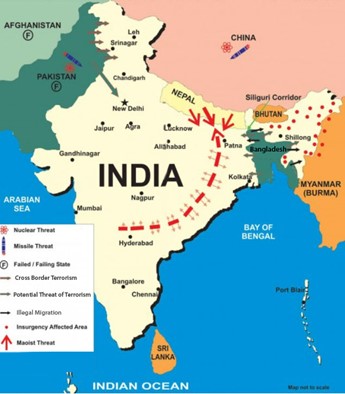
About National Security Strategy (NSS):
- A National Security Strategy articulates a country's security objectives, identifies internal and external challenges, and offers directives for achieving national goals.
- It addresses both traditional and non-traditional threats, emphasising accountability in executing these responsibilities.
- The NSS guides military strategies, defence reforms, and overall security perspectives, providing a comprehensive framework for safeguarding national interests.
|
What is National Security ?
|
Strategic Relations with the US and Competition with China:
- China’s Multifaceted Challenges: China presents interconnected challenges, including naval expansion, economic influence in South Asia, and global supply chain dominance.
- Strategic Relations with the US: India must balance its partnership with the US while addressing competition from China.
- Global Conflicts Impact: Distant conflicts like those in Ukraine and Gaza introduce new war technologies and tactics that could affect India’s regional defence strategies.
Why India Needs a National Security Strategy (NSS):
- Formal Security Policies and Frameworks: India lacks formal security policies, increasing the risk of mishandling security incidents and allowing adversaries like Pakistan to exploit perceived gaps without fearing consequences.
- Example of Jointness in Indian Military: The concept of jointness in the Indian military, which aims to integrate uniformed services and civilian personnel, lacks clear definition and implementation, highlighting the need for structured guidance.
- Military Modernization Imperative: An NSS is crucial for accelerating India's military modernization efforts and implementing theatre commands. Current defence reforms stall due to the absence of a cohesive national security strategy.
- The Two-Front Threat: Since the late 1960s, the politico-economic-military relationship between China and Pakistan has posed a consistent two-front threat to India, necessitating a comprehensive national security strategy to address this challenge effectively.
- Fluid Neighborhood Dynamics: Instabilities in neighbouring countries like Afghanistan, Pakistan, Sri Lanka, and Myanmar underscore the need for a structured NSS to navigate and manage regional security complexities proactively.
- Comprehensive Framework for Diplomacy and Strategy: An NSS serves as a foundational framework encompassing diplomacy, strategy, and foreign policy, enabling India to anticipate future threats and effectively deter aggression.
- Integrated Approach to Information Warfare: Emerging threats like information warfare highlight the vulnerability of telecom, banking, and power sectors to disruptions. An NSS is essential for coordinating a robust cybersecurity response to mitigate these risks.
Challenges Ahead for the Indian Government:
- Military Investments: Decisions on crucial defence projects such as constructing another aircraft carrier and implementing theaterisation.
- Holistic National Security: Need for comprehensive national security planning to avoid inefficient resource use and protect national objectives.
- Managing Strategic Risks: Coordinated policies essential to tackle risks like climate change, pandemics, and China's rising influence.
- Synchronising Efforts: Enhancing coordination among government branches, military, and security agencies for more effective operations.
Blueprint for Strengthening National Power:
- Comprehensive Strategic Assessment: A National Security Strategy (NSS) mandates thorough evaluation of threats, opportunities, and global security trends.
- Framework for Long-Term Planning: An NSS offers a structured approach for effective resource allocation, military capability development, and international partnerships.
- Signalling Intent to Allies and Adversaries: An NSS defines India’s strategic priorities, highlighting its role as a security provider in the Indian Ocean and its regional security stance.
- Coordinated National Security Efforts: An NSS promotes coherence among national security agencies and military branches, enhancing coordination and integration.
Accountability in National Security:
- Transparency and Accountability: An NSS ensures government policies are transparent and accountable to Parliament and citizens.
- Adherence to Political Leadership: It ensures bureaucracy follows strategic direction set by political leadership.
- Public Document: An endorsed NSS by the Prime Minister synchronises efforts and signals intent nationally and internationally.
- Rational Decision-Making: NSS aids in identifying trade-offs for informed decisions on national growth and security.
Conclusion:
Establishing a coherent strategic framework within the NSS is imperative to outline India’s national security objectives, priorities, and methodologies. This framework should steer decisions on defence investments, international partnerships, and strategies to address global challenges such as climate change and pandemics.
|
UPSC Civil Services Examination, Previous Year Questions (PYQs) Mains: Q:1 What introduces friction into the ties between India and the United States is that Washington is still unable to find for India a position in its global strategy, which would satisfy India’s National self-esteem. (2019) Q:2 The broader aims and objectives of the WTO are to manage and promote international trade in the era of globalisation. But the Doha round of negotiations seem doomed due to differences between the developed and the developing countries.” Discuss in the Indian perspective.(UPSC 2016) |
Source: TH
Tenth Spectrum Auction for Radio Waves
Why in the News?
- Recently, an auction for spectrum worth ₹96,238 crore started on June 25, 2024. Companies like Airtel and Reliance Jio are expected to bid for airwaves to enhance their 5G services.

- This is the 10th spectrum auction since the process for the sale of radio waves started through an online bidding process in 2010.
- The last spectrum auction was held in August 2022, which, for the first time, included radio waves for 5G services.
Airwaves/Spectrum:
- Airwaves are radio frequencies within the electromagnetic spectrum that can carry information wirelessly for a range of services including telecommunications.
- The government manages and allocates airwaves to companies or sectors for their use.
- The government auctions a fixed amount of spectrum within specified bands to be utilised by operators for providing communication services to consumers.
Types of Spectrum Band:
- Low Band Spectrum: Less than 1 GHz (600 MHz, 700 MHz, 800 MHz, 900 MHz)
- Offers blanket coverage suitable to serve thousands of customers over long distances with fewer towers.
- Ideal for wide and in-building coverage.
- When bundled with high-spectrum bands, it can be used for commercial mobile and broadcasting services.
- Mid-Band Spectrum: Ranges from 1 GHz to 6 GHz (1800 MHz, 2100 MHz, and 2300 MHz)
- Provides coverage as well as the capacity to carry more data while travelling significant distances.
- High Band Spectrum: Ranges from 24 GHz to 40 GHz and is also known as the millimetre wave spectrum.
- Ideal for speedy networks over short ranges.
- However, this range is subject to interference from dense objects.
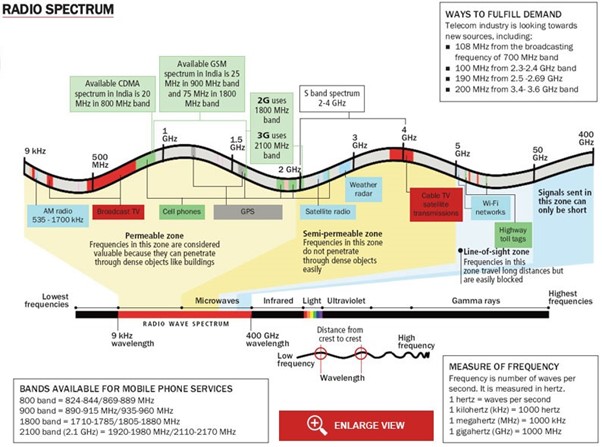
What Spectrum Do Telecom Companies Require?
- According to the GSM Association, for telecom purposes, spectrum in the 400 MHz to 4 GHz range is the most optimum.
- Operators can provide 2G, 3G, 4G, and 5G services using one frequency band if they have enough spectrum.
For Mobile Technology in India:
- 2G services use the 900 MHz and 1800 MHz bands
- 3G uses 900 MHz and 2100 MHz
- 4G uses 850 MHz, 1800 MHz, 2300 MHz, and 2500 MHz
- 5G uses 3.5 MHz and 700 MHz bands
Spectrum Allocation – Only Through Auction:
- Spectrum, considered a scarce natural resource, was ordered by the top Court to be allocated through the fair and impartial process of auction.
Case Originated in 2008:
- The alleged 2G spectrum allocation scam is said to have originated in 2008 when the then government sold 122 2G licences on a first-come-first-serve (FCFS) basis to specific telecom operators.
- In its charge sheet filed in April 2011, the CBI alleged that there was a loss of ₹30,984 crore to the exchequer as a result of discrepancies in the allocation process.
Matter Reaches SC:
- Petitions were filed in the top Court alleging a ₹70,000 crore scam in the grant of telecom licences in 2008.
- In February 2012, a division Bench of the SC cancelled the licences while cautioning that an FCFS basis for the allocation of scarce natural resources can be prone to misuse.
Competitive Auctions for Allocating Natural Resources:
- In its judgement, the apex court advocated for competitive auctions as the only route to allocate spectrum.
- It further emphasised that the burden lies on the state to ensure that the non-discriminatory method of auction is adopted by giving wide publicity so that all eligible persons can participate in the process.
2012 Presidential Reference on 2G Verdict:
- In 2012, the then President Pratibha Patil sought the Supreme Court's opinion on several questions arising from the 2012 SC judgement regarding the allocation of 2G spectrum licences.
- Under Article 143 of the Constitution of India, the President is empowered to refer to the Supreme Court any matter of law or fact.
- The Supreme Court emphasised that the decision to use auctions or other methods should be based on a case-by-case assessment of the resource in question, considering public interest and policy objectives.
Centre Sought a Clarification of the 2G Spectrum Scam Verdict:
- In April 2024, the Union government moved an application for a certain class of spectrum to be allocated through administrative processes instead of competitive auctions.
- An administrative allocation would mean that the government will have the final say in deciding the procedure for selecting operators.
- However, the apex Court of India refused to entertain the Centre's plea to allow the administrative allocation of spectrum.
Tenth Spectrum Auction for Radio Waves:
- The Department of Telecommunications (DoT) has initiated the spectrum auction.
- The Ministry of Communications announced that the following spectrum bands will go up for bidding in the upcoming auction - 800 MHz, 900 MHz, 1800 MHz, 2100 MHz, 2300 MHz, 2500 MHz, 3300 MHz, and 26 GHz.
- The 3300 MHz band and 26 GHz band are seen as suitable bands for 5G services.
- The total quantum of spectrum being auctioned is 10,522.35 MHz in various bands valuing ₹96,238.45 crores at reserve prices.
Source: TH
Water deficit in flagship Jal Jeevan Mission
Why in the news?
- Recently, the Union Jal Shakti Minister announced a new project aimed at ensuring that rural households, which received taps under the ambitious Jal Jeevan Mission (JJM) but have not yet availed water, would soon be provided potable water.
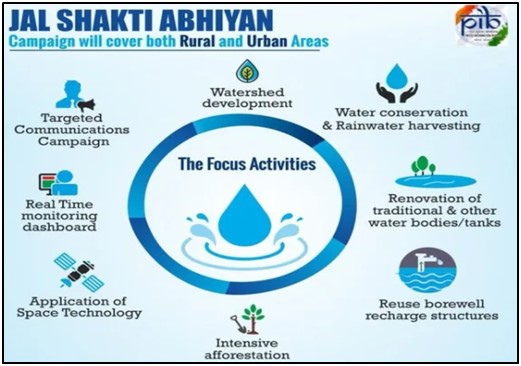
Jal Jeevan Mission (JJM):
About:
- Envisioned to provide safe and adequate drinking water through individual household tap connections by 2024 to all households in rural India.
- Launched on August 15, 2019.
- Focuses on assured and regular potable water service delivery at household level (55 litres per person per day).
- Decentralised, demand-driven, and community-managed programme aiming to instil a ‘sense of ownership’ among the local community.
- The Department of Drinking Water & Sanitation under the Ministry of Jal Shakti is responsible for implementing this mission.
Key Details:
- Implements source sustainability measures as mandatory elements:
- Recharge and reuse through grey water management, water conservation, rainwater harvesting.
- Based on a community approach to water, including extensive Information, Education, and Communication.
- Aims to create a jan andolan for water, making it everyone’s priority.
Focus Vision:
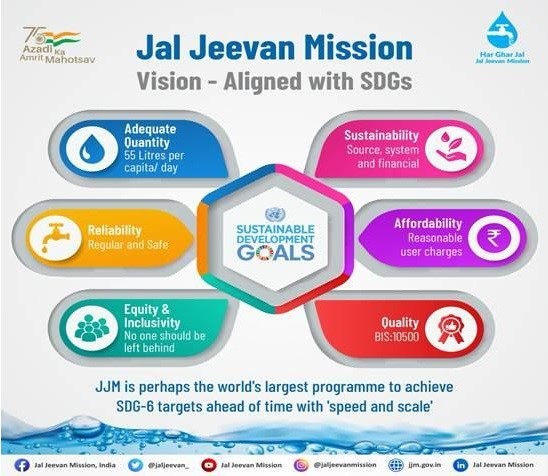
Measurement Process:
- State or Union Territory water supply departments collect data from districts and report it to the Jal Shakti Ministry to measure water connections provided to households.
- Data shows that 19 crore rural households have been given tap connections.
- Villages, through their gram panchayats, self-certify if households actually receive water, double-checking state-provided figures.
Performance of the Scheme:
- Status of Tap Water Supply in Rural Homes
- As of June 26, 2024, the scheme encompassed 77% of its target households.
- Households with tap water connections as of June 26, 2024: 14,91,32,648 (77.22%).
- However, there is a difference between a household getting a tap connection and the daily quota of 55 litres per person per day of water being provided.
- Har Ghar Jal Status
- Achieving the Har Ghar Jal Status means:
- All households have been connected.
- The water supply department has certified water supply to homes, schools, and anganwadis.
- A gram sabha resolution has confirmed the department's claim.
- Certified States/UTs (certified by the Ministry):
- Goa, A & N Islands, Puducherry, D&NH and D&D, Arunachal Pradesh, Haryana, Punjab.
- Reported States/UTs:
- Telangana, Mizoram, Himachal Pradesh, Gujarat.
- The Jal Shakti Ministry portal shows target achievements by States.
- Out of 2,24,678 villages claiming 100% tap connectivity, only 1,21,974 have self-certified.
- It is unclear how many of the 19 crore households truly have functional tap water connections.
- Achieving the Har Ghar Jal Status means:
Challenges to JJM:
- Infrastructure Development
- Establishing necessary infrastructure in remote and rural areas, including pipelines, water treatment plants, and storage facilities.
- Water Quality
- Ensuring the quality of water supplied through the taps.
- Contaminants like fluoride, arsenic, and nitrates in groundwater sources require robust treatment solutions.
- Sustainability
- Maintaining water supply systems and ensuring they remain functional over time.
- Regular maintenance, timely repairs, and efficient management of water resources.
- Funding and Resources
- Adequate funding and resource allocation are vital for success.
- Ensuring states and local bodies have the financial and human resources to implement and maintain the systems is a continuous challenge.
- Community Participation
- Engaging local communities and ensuring their active participation in planning, implementation, and maintenance.
- Building awareness and training local stakeholders is necessary for success.
- Geographical Challenges
- Diverse geographical conditions across India, such as hilly terrains, deserts, and densely populated areas, present unique challenges in laying pipelines and ensuring a consistent water supply.
- Data Accuracy and Verification
- Accurately reporting and verifying the number of functional household tap connections.
- The self-certification process by gram panchayats is essential but can be prone to discrepancies.
- Coordination Among Agencies
- Effective coordination between various government agencies at the central, state, and local levels.
- Overcoming bureaucratic hurdles and ensuring seamless collaboration can be difficult
|
UPSC Civil Services Examination Previous Year Question (PYQ) Mains Q:1 What is water stress? How and why does it differ regionally in India? (2019) |
Source:TH
Deputy Speaker of Lok Sabha
Why in the News?
- With the Opposition becoming stronger in the 18th Lok Sabha, its members are vying for the office of Deputy Speaker. However, the government has not provided assurances on this post, forcing the Opposition to run for Speaker for the first time since 1952.

Office of Deputy Speaker of Lok Sabha:
- Appointment:
- Article 93: Mandates the House of the People to choose a Speaker and a Deputy Speaker as soon as possible.
- Article 178: Provides the same for Speakers and Deputy Speakers in state Assemblies.
- Parliamentary convention typically elects a Deputy Speaker from a party other than the ruling party to maintain democratic accountability.
- Time Frame to Appoint a Deputy Speaker:
- The Constitution does not specify a time frame for the appointments, allowing governments to delay or avoid appointing a Deputy Speaker.
- Constitutional experts emphasise that both Articles 93 and 178 use "shall" and "as soon as may be," indicating that the election is mandatory and should be held at the earliest.
- Powers:
- Article 95(1): The Deputy Speaker performs the duties of the Speaker if the post is vacant.
- Example: M Ananthasayanam Ayyangar served as Speaker from 1956 to 1957 after G V Mavalankar's death.
- Example: P M Sayeed served as acting Speaker for two months in 2002 after G M C Balayogi's death.
- The Deputy Speaker has the same powers as the Speaker when presiding over the House.
- All references to the Speaker are deemed to include the Deputy Speaker when they preside.
- Article 95(1): The Deputy Speaker performs the duties of the Speaker if the post is vacant.
- Removal from Office:
- The Deputy Speaker usually continues in office until the dissolution of the House.
- Article 94 (and Article 179 for state Assemblies): The Speaker or Deputy Speaker vacates office if they cease to be a member of the House, resign, or are removed by a resolution passed by a majority of all the then members of the House.
Rules for the Election of the Deputy Speaker of Lok Sabha:
- Election of the Speaker:
- Typically elected in the first session of the new House, usually on the third day after the oath-taking and affirmations.
- Election of the Deputy Speaker:
- Generally not delayed beyond the second session unless there are genuine and unavoidable constraints.
- No bar on holding the election in the first session.
- Governed by Rule 8 of the Rules of Procedure and Conduct of Business in Lok Sabha, with the election held on a date fixed by the Speaker.
Office of Deputy Speaker of Lok Sabha Held by the Opposition Since 1952:
- 1952 to 1969: First four Deputy Speakers were from the ruling Congress.
- 1969 to 1977: G G Swell of the All-Party Hill Leaders Conference.
- 1977 to 1979: Godey Murahari of the Congress during the Janata Party government.
- 1980 to 1984: DMK’s G Lakshmanan during Indira Gandhi’s government.
- 8th Lok Sabha (1984-89): AIADMK’s Thambi Durai.
- 1990-91: Shivraj Patil (Congress) during Chandra Shekhar’s tenure.
- 10th Lok Sabha (1991-96): S Mallikarjunaiah (BJP) during P V Narasimha Rao’s tenure.
- UPA-I (2004-09) and UPA-II (2009-14): Deputy Speaker’s post held by the Opposition - Charanjit Singh Atwal (Shiromani Akali Dal), Kariya Munda (BJP).
- 17th Lok Sabha (2019-2024): The first and only Lok Sabha without a Deputy Speaker.
- 2023: A bench led by CJI sought responses on a PIL contending that not electing a Deputy Speaker is against the letter and spirit of the Constitution.
|
UPSC Civil Services Examination, Previous Year Question (PYQ) Prelims Q1. Consider the following statements: (2017)
Which of the statements given above is/are correct? (a) 1 only (b) 2 only (c) Both 1 and 2 (d) Neither 1 nor 2 Ans: (d)
Q2. Regarding the office of the Lok Sabha speaker, consider the following statements: (2012)
Which of the statements given above is/are correct? (a) 1 and 2 only (b) 3 only (c) 1, 2 and 3 (d) None Ans: (b) |
Source: IE
China’s Lunar Mission: Chang’e-6
Why in the News?
- Recently, China’s Chang’e-6 has become the first spacecraft to bring back samples from the far side of the Moon, which is never visible from Earth.
- The probe landed in northern China on June 25th, in the Inner Mongolian region, after a 53-day journey that began on May 3rd.
- The probe successfully drilled into the lunar core and collected rock samples.
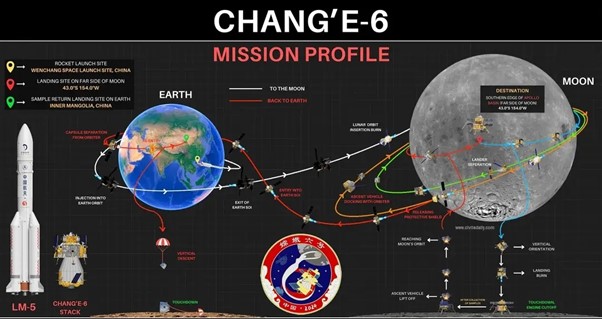
China’s Lunar Mission:
- Objectives:
- Sample Return Mission: The main goal of Chang'e-6 was to collect and return lunar samples to Earth.
- Technological Demonstration: The mission aims to showcase and refine technologies for lunar landing, sampling, and returning to Earth, essential for future lunar exploration missions.
- Mission Details:
- Landing Site: Chang'e-6 aimed for the lunar far side, specifically the South Pole-Aitken Basin, one of the Moon's largest and oldest impact basins, noted for its unique geological features.
- Spacecraft Components: The mission included an orbiter, a lander, an ascent vehicle, and a return capsule. The orbiter stayed in lunar orbit, while the lander collected samples from the Moon's surface.
- Sample Collection: The lander used a robotic arm and a drill to gather samples from both the lunar surface and subsurface.
Significance of Chang'e-6 Lunar Mission:
- Advanced Analysis: Returned samples allow for detailed examination using sophisticated laboratory instruments, providing comprehensive data on chemical, isotopic, mineralogical, structural, and physical properties, from macroscopic to atomic scales.
- Preservation for Future Study: Samples can be preserved for decades, enabling future generations to study them with advanced technology, as shown by the Apollo mission samples.
- Comparative Missions: India's Chandrayaan-4, currently under development by ISRO, is also a sample return mission, following the successful landing of Chandrayaan-3 near the Moon's South Pole.
What Can the Samples Brought by Chang’e-6 Reveal?
- Geological Insights: The far side of the Moon has a thicker crust, more craters, and fewer lava plains than the near side.
- Lunar History: Samples from the South Pole-Aitken basin could provide information on the timeline of lunar cratering and the Moon’s origins.
- Future Exploration: These samples could aid future exploration by suggesting ways to use lunar resources, such as using lunar soil for 3D-printed bricks for research bases or extracting ice at the poles for water, oxygen, and hydrogen (the latter two for rocket fuel).
Countries’ Race to the Moon:
- In 2023, India, China, Japan, the US, and Russia all launched lunar missions.
- By 2030, more than 100 Moon missions by both governments and private companies are expected, according to the European Space Agency.
- Both China and the US aim to send astronauts to the Moon by 2030. The success of Chang’e-6 is a significant step towards China achieving this goal.
Source: IE
350th Anniversary of Chhatrapati Shivaji’s Coronation
Why in the news ?
- Recently, the Indira Gandhi National Centre for the Arts (IGNCA) and the National Gallery of Modern Art (NGMA) organised an exhibition to mark the 350th anniversary of Chhatrapati Shivaji Maharaj's coronation.
- The exhibition featured 115 oil paintings depicting Shivaji Maharaj.

About the Shivaji:
Birth:
- He was born on 19th February 1630 at Shivneri Fort in District Pune in the present-day state of Maharashtra.
- He was born to Shahaji Bhonsle, a Maratha general who held the jagirs of Pune and Supe under the Bijapur Sultanate, and Jijabai, a pious woman whose religious qualities had a profound influence on him.
Early Life:
- He displayed his military zeal for the first time in 1645 when, as a teenager, he successfully took control of the Torna Fort, which was under Bijapur.
- He also acquired the Kondana Fort. Both these forts were under Adil Shah of Bijapur.
Important Battle:
|
Battle |
Year |
Location |
Combatants |
|
Battle of Pratapgad |
1659 |
Pratapgad Fort, near Satara, Maharashtra |
Maratha forces (Chhatrapati Shivaji Maharaj) vs. Adilshahi (Afzal Khan) |
|
Battle of Pavan Khind |
1660 |
Mountain pass near Fort Vishalgad, near Kolhapur, Maharashtra |
Maratha forces (Baji Prabhu Deshpande) vs. Adilshahi (Siddi Masud) |
|
Sacking of Surat |
1664 |
Near the city of Surat, Gujarat |
Maratha forces (Chhatrapati Shivaji Maharaj) vs. Mughal forces (Inayat Khan) |
|
Battle of Purandar |
1665 |
Purandar Fort, Maharashtra |
Mughal Empire vs. Maratha Empire |
|
Battle of Sinhagad |
1670 |
Sinhagad Fort, near Pune, Maharashtra |
Maratha forces (Tanaji Malusare) vs. Mughal forces (Udaybhan Rathod) |
|
Battle of Kalyan |
1682-83 |
Kalyan, Maharashtra |
Mughal Empire (Bahadur Khan) vs. Maratha Empire |
|
Battle of Sangamner |
1679 |
Sangamner, Maharashtra |
Mughal Empire vs. Maratha Empire |
|
Administration under Shivaji |
Details |
|
Central Administration |
Shivaji established a sound system of administration inspired by the Deccan style and Malik Amber's reforms. He was the supreme head, assisted by the ‘Ashtapradhan’ (council of eight ministers), with the peshwa as chief. |
|
Revenue Administration |
Shivaji replaced the Jagirdari System with the Ryotwari System, reforming the roles of hereditary officials like Deshmukhs, Deshpande, Patils, and Kulkarnis. Revenue was based on Malik Amber's Kathi system. |
|
Military Administration |
Shivaji's army was disciplined and efficient, with ordinary soldiers paid in cash and chiefs via jagir grants. The army included Infantry (Mavali foot soldiers), Cavalry (horse riders), and a Navy. |
Public Examination Rules, 2024
Why in the news ?
- Recently, the Union Ministry of Personnel, Public Grievances and Pensions has notified the rules under the Public Examinations (Prevention of Unfair Means) Act, 2024, which came into effect on June 21, 2024.
Key Highlights of the Rules:
- Venue-in-charge is empowered to take appropriate action, including filing an FIR, if a prima facie case of unfair means or an offence in the conduct of public examinations is reported.
- A committee will be constituted by the public examination authority if there is involvement of the Management or Board of Directors of the service provider.
- A service provider refers to any agency, organisation, body, association of persons, business entity, etc., engaged by the public examination authority for conducting public examinations.
- Regional officers must periodically report all incidents of unfair means or offences in the conduct of public examinations to the public examination authority, including details of actions taken.
Public Examinations (Prevention of Unfair Means) Act, 2024:
- "Unfair means" includes unauthorised access or leakage of question papers or answer keys, assisting a candidate during a public examination, tampering with computer networks or resources, conducting fake examinations, etc.
Punishments:
- For individuals resorting to unfair means: Imprisonment for a term not less than three years, which may extend to five years, along with a fine up to ten lakh rupees.
- For service providers or any person/group committing organised crime: Imposition of a fine up to ₹1 crore, with the proportionate cost of the examination also to be recovered from them.
- All offences are cognizable, non-bailable, and non-compoundable
Source: NDTV
CDRI Policy Brief on Developing Power Sector Resilience
Why in the news ?
- The Policy Brief by the Coalition for Disaster Resilient Infrastructure (CDRI) explores disaster resilience strategies for the power sector, specifically against cyclones and floods, with a focus on the measures undertaken by Odisha.
Disaster Resilience:
- Disaster resilience involves anticipating, planning, and reducing disaster risk to protect people, communities, and countries, as well as their livelihoods, health, cultural heritage, socio-economic assets, and ecosystems effectively.
Key Findings for Odisha’s Transmission and Distribution (T&D) Infrastructure:
- 80% of electricity poles are vulnerable to high wind speeds.
- Over 75% of distribution lines cannot withstand cyclonic winds.
- The situation is likely similar in other coastal states.
Key Policy Recommendations:
- Enhance Codes and Standards for Wind Zonation:
- Regularly update wind zonation maps to reflect the most recent and localised meteorological data.
- Create Data Access Platforms for Physical Climate Risks:
- Facilitate clear communication and collaboration with disaster management authorities.
- Risk-informed Governance:
- Incorporate resilience components in policy, training, and capacity-building initiatives.
- Develop a cross-sectoral framework for enhanced stakeholder collaboration.
- Innovative Financing Solutions:
- Utilise insurance, reinsurance, Catastrophe (CAT) bonds, and create a “Grant” component for Power Utilities to address emergent needs.
|
About CDRI:
|
Source: ET
Sustainable Development in the Indian Himalayan Region
Context:
- The Indian Himalayan Region (IHR) is India's "water tower" and provides vital ecosystem services. However, there's a disconnect between the region's development needs and current development models.
- The IHR's economy relies on its natural resources, and exploiting them under the guise of development threatens economic decline. Sustainable management of these resources is essential to avoid this outcome.
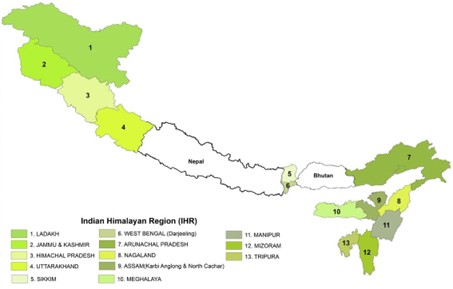
What is The Indian Himalayan Region (IHR)?
About:
- The IHR refers to the mountainous area in India encompassing the entire Himalayan range within the country.
- It spans 13 Indian States/Union Territories: Jammu and Kashmir, Ladakh, Uttarakhand, Himachal Pradesh, Arunachal Pradesh, Manipur, Meghalaya, Mizoram, Nagaland, Sikkim, Tripura, Assam, and West Bengal.
- The IHR stretches across 2500 km.
Significance:
- The IHR includes some of the world's highest peaks, such as Kanchenjunga.
- Known as India's "water tower," it is the source of many major rivers, including the Ganges, Yamuna, Brahmaputra, and their tributaries.
- It plays a crucial role in regulating the ecological balance and maintaining biodiversity.
- The region is home to a rich variety of flora and fauna, with many endemic and endangered species.
- It includes several national parks, wildlife sanctuaries, and biosphere reserves, such as the Valley of Flowers National Park and Nanda Devi National Park.
- The IHR influences the climate and weather patterns of the Indian subcontinent, acting as a barrier to cold winds from Central Asia and affecting monsoon patterns.
- The region is inhabited by diverse ethnic communities with unique cultures, languages, and traditions.
- It includes important religious and pilgrimage sites for various faiths, such as Amarnath and Badrinath.
- The IHR holds strategic importance due to its location along India's northern borders with China, Nepal, and Bhutan.
Key Environmental Concerns in the Indian Himalayan Region
● Climate Change and Glacial Melting
- The Himalayan glaciers are melting rapidly due to global warming, affecting water resources downstream.
- Changes in temperature and precipitation patterns disrupt local climates, impacting agriculture and livelihoods.
- The IHR is increasingly experiencing natural disasters such as flash floods, glacial lake outburst floods (GLOFs), and extreme weather events.
- Glaciers in the IHR are retreating at an average rate of 10 to 60 metres per year, with the Gangotri Glacier having retreated by more than 1,500 metres in the last 70 years.
- The 2013 Kedarnath disaster was exacerbated by rapid glacial melting, leading to catastrophic flooding and massive destruction.
● Soil Erosion and Landslides
- Deforestation, unplanned construction, and overgrazing contribute to soil erosion.
- The region is highly prone to landslides, especially during the monsoon season, causing damage to property, infrastructure, and loss of life.
- In 2021, the Chamoli district in Uttarakhand witnessed a massive landslide triggered by glacial outburst floods, resulting in unprecedented damage to life and infrastructure.
● Water Scarcity and Pollution
- Many areas within the IHR face water scarcity due to the drying up of springs and streams.
- Pollution from agricultural runoff, untreated sewage, and industrial effluents contaminates water sources, impacting human health and ecosystems.
- A study by the Central Ground Water Board (CGWB) indicates that more than 50% of the springs in the Indian Himalayas are drying up, affecting water availability for millions.
● Developmental Projects
- The construction of numerous hydroelectric power stations disrupts river ecosystems, affects fish populations, and displaces local communities.
- Infrastructure projects often ignore environmental norms, leading to ecological damage and heightened disaster risks.
- The National Disaster Management Authority's post-disaster assessment of the 2023 floods in Himachal Pradesh attributed the disaster to widespread illegal construction on river beds and floodplains.
● Air Pollution
- Increased vehicular emissions, industrial activities, and biomass burning contribute to deteriorating air quality.
- The mountainous terrain can trap pollutants, leading to health issues for residents and reduced visibility.
- The town of Leh in Ladakh has seen rising air pollution levels due to increased vehicular traffic and construction activities, impacting the health of residents and tourists alike.
● Deforestation and Habitat Loss
- The IHR is home to over 10,000 plant species, 300 mammal species, and 1,000 bird species, with many listed as endangered.
- Large-scale deforestation for agriculture, urban development, and infrastructure projects leads to habitat destruction and loss of biodiversity.
- A decline of 902 square kilometres in forest cover was recorded in hill districts of the country as compared to 2019, according to the State of Forest Report, 2021.
- The loss is much more pronounced in the Himalayan states, which reported an overall loss of 1,072 sq km of forest cover.
Supreme Court Judgments Support Environmental Conservation Efforts in the IHR:
● Recognition of the Right against Climate Change
- Supreme Court Ruling:
- In the case of M K Ranjitsinh & Ors. v. Union of India & Ors., The Supreme Court ruled that people have a right to be free from adverse climate change impacts.
- This right is recognized under Articles 14 and 21 of the Constitution.
- Implications:
- This recognition is a crucial step towards safeguarding environmental and human rights.
- It creates an obligation for the government to implement effective measures to combat climate change.
● Adoption of an Ecocentric View of the Environment:
- Supreme Court Directive:
- In the case of State of Telangana and Others vs Mohd. Abdul Qasim, the Supreme Court emphasised the need to adopt an ecocentric view of the environment, placing nature at the core.
- Court's Statement:
- The Court stated, "Man being an enlightened species, is expected to act as a trustee of the Earth.
- The time has come for mankind to live sustainably and respect the rights of rivers, lakes, beaches, estuaries, ridges, trees, mountains, seas, and air. Man is bound by nature’s law."
● Directions on the Carrying Capacity of the Himalayan States:
- Public Interest Litigation (PIL):
- In the PIL titled Ashok Kumar Raghav vs Union of India and Ors., the Supreme Court asked the central government and the petitioner to suggest a way forward to enable the Court to pass directions on the carrying capacity of the Himalayan States and towns
Measures can be taken to Promote Sustainable Development in the IHR:
● Climate-Resilient Infrastructure:
- Adopt Building Codes: Implement construction practices resilient to earthquakes, landslides, and floods.
- Green Infrastructure: Invest in permeable pavements, green roofs, and bioswales to manage stormwater and reduce urban heat islands.
- Ban Construction in Disaster-Prone Areas: Enforce a complete ban on construction activities in disaster-prone areas as suggested by the Mishra Committee, 1976.
● Integrated Land Use Planning:
- Land Use Plans: Develop plans demarcating zones for conservation, agriculture, residential, and industrial activities.
- GIS and Remote Sensing: Utilise these technologies for effective land use planning and monitoring environmental changes.
- WGEEP Recommendations: Follow the zoning system for the Western Ghats recommended by the Western Ghats Ecology Expert Panel (WGEEP) to balance conservation and development needs.
● Water Resource Management:
- Rainwater Harvesting: Promote installation in urban and rural areas.
- Springshed Management: Restore and manage spring sheds for sustainable water sources.
- NGRBA Recommendations: Implement comprehensive approaches to clean and rejuvenate the Ganga River, addressing pollution sources and promoting sustainable practices.
● Forest and Biodiversity Conservation:
- Reforestation Projects: Initiate large-scale projects to restore degraded lands and enhance biodiversity.
- Community Management: Empower local communities to manage and protect forest resources through joint forest management programs, exemplified by the Chipko Movement.
- Endangered Species Programs: Develop and implement conservation programs for endangered species and their habitats.
- NMSHE Initiatives: Focus on addressing climate change impacts, promoting sustainable livelihoods, and conserving biodiversity in the Indian Himalayan Region.
● Sustainable Agriculture:
- Organic Farming: Encourage practices to reduce chemical inputs and maintain soil health.
- Micro-Hydropower Projects: Develop projects with minimal environmental impact.
- Agroforestry: Integrate trees and shrubs into agricultural systems to enhance biodiversity, reduce erosion, and improve crop yields.
- Sikkim's Organic State: Follow Sikkim’s example of becoming fully organic, reducing chemical pesticide and fertiliser use.
● Eco-Friendly Tourism:
- Carrying Capacity Assessments: Regulate the number of tourists to minimise environmental impact.
- Eco-Tourism Initiatives: Promote sustainable practices and provide economic benefits to local communities.
- Reduce Plastic Waste: Promote the use of biodegradable materials and reduce plastic waste.
- NDMA Recommendations: Create buffer zones and restrict tourism in Glacial Lake Outburst Floods (GLOFs)-prone areas to reduce pollution.
● Monitoring and Research:
- Environmental Monitoring Systems: Establish robust systems to track changes and assess the impact of development activities.
- Support Research: Focus on sustainable development practices, climate change adaptation, and biodiversity conservation.
- HLEG Report: Follow the High-Level Expert Group’s recommendations on monitoring Himalayan glaciers and understanding their role in regional water resources.
● Education and Awareness:
- School Curricula: Include basic knowledge of the geology and ecology of the Himalayas to connect students with their environment.
- Community Awareness: Educate residents about the geological vulnerability and ecological fragility of the Himalayas to promote compliance with environmental laws and regulations.
|
What are the Government Initiatives to Protect IHR?
|
Conclusion:
Thus, in response to recent Supreme Court rulings recognizing the right to protection from climate change, it's crucial that the Indian Himalayan Region (IHR) adopts a sustainable development model within its ecological limits. This approach must prioritise environmental preservation while fostering community prosperity and well-being through balanced development practices.
|
UPSC Civil Services Examination, Previous Year Questions (PYQs) Prelims: Q:1 Consider the following pairs: (2020)
Which of the pairs given above is/are correctly matched? (a) 1 and 2 (b) 2 only (c) 1 and 3 (d) 3 only Ans: (b) Q:2 If you travel through the Himalayas, you are likely to see which of the following plants are naturally growing there? (2014)
Select the correct answer using the code given below: (a) 1 and 2 only (b) 3 only (c) 1 and 3 only (d) 1, 2 and 3 Ans: (a)
Q:3 When you travel in Himalayas, you will see the following: (2012)
Which of the above can be said to be the evidence for Himalayas being young fold mountains? (a) 1 and 2 only (b) 1, 2 and 4 only (c) 3 and 4 only (d) 1, 2, 3 and 4 Ans: (d)
Mains: Q1. Differentiate the causes of landslides in the Himalayan region and Western Ghats. (2021) Q2. How will the melting of Himalayan glaciers have a far-reaching impact on the water resources of India? (2020) Q3. “The Himalayas are highly prone to landslides.” Discuss the causes and suggest suitable measures of mitigation. (2016) |
||||||||
|
|
Source: TH
Share the article
Edukemy’s Current Affairs Quiz is published with multiple choice questions for UPSC exams
MCQ
Get Latest Updates on Offers, Event dates, and free Mentorship sessions.

Get in touch with our Expert Academic Counsellors 👋
FAQs
UPSC Daily Current Affairs focuses on learning current events on a daily basis. An aspirant needs to study regular and updated information about current events, news, and relevant topics that are important for UPSC aspirants. It covers national and international affairs, government policies, socio-economic issues, science and technology advancements, and more.
UPSC Daily Current Affairs provides aspirants with a concise and comprehensive overview of the latest happenings and developments across various fields. It helps aspirants stay updated with current affairs and provides them with valuable insights and analysis, which are essential for answering questions in the UPSC examinations. It enhances their knowledge, analytical skills, and ability to connect current affairs with the UPSC syllabus.
UPSC Daily Current Affairs covers a wide range of topics, including politics, economics, science and technology, environment, social issues, governance, international relations, and more. It offers news summaries, in-depth analyses, editorials, opinion pieces, and relevant study materials. It also provides practice questions and quizzes to help aspirants test their understanding of current affairs.
Edukemy's UPSC Daily Current Affairs can be accessed through:
- UPSC Daily Current Affairs can be accessed through Current Affairs tab at the top of the Main Page of Edukemy.
- Edukemy Mobile app: The Daily Current Affairs can also be access through Edukemy Mobile App.
- Social media: Follow Edukemy’s official social media accounts or pages that provide UPSC Daily Current Affairs updates, including Facebook, Twitter, or Telegram channels.

